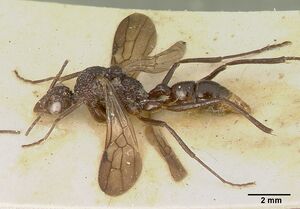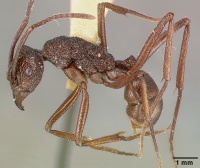Rhytidoponera strigosa
| Rhytidoponera strigosa | |
|---|---|

| |
| Scientific classification | |
| Kingdom: | Animalia |
| Phylum: | Arthropoda |
| Class: | Insecta |
| Order: | Hymenoptera |
| Family: | Formicidae |
| Subfamily: | Ectatomminae |
| Tribe: | Ectatommini |
| Genus: | Rhytidoponera |
| Species: | R. strigosa |
| Binomial name | |
| Rhytidoponera strigosa (Emery, 1887) | |
| Synonyms | |
| |
Identification
Distribution
Latitudinal Distribution Pattern
Latitudinal Range: -0.93333° to -7.734722222°.
| North Temperate |
North Subtropical |
Tropical | South Subtropical |
South Temperate |
- Source: AntMaps
Distribution based on Regional Taxon Lists
Indo-Australian Region: New Guinea (type locality).
Distribution based on AntMaps
Distribution based on AntWeb specimens
Check data from AntWeb
Countries Occupied
| Number of countries occupied by this species based on AntWiki Regional Taxon Lists. In general, fewer countries occupied indicates a narrower range, while more countries indicates a more widespread species. |

|
Estimated Abundance
| Relative abundance based on number of AntMaps records per species (this species within the purple bar). Fewer records (to the left) indicates a less abundant/encountered species while more records (to the right) indicates more abundant/encountered species. |

|
Biology
Castes
Male
Images from AntWeb
  
| |
| Syntype of Rhytidoponera nitens. Male (alate). Specimen code castype06988-02. Photographer April Nobile, uploaded by California Academy of Sciences. | Owned by CAS, San Francisco, CA, USA. |
Nomenclature
The following information is derived from Barry Bolton's Online Catalogue of the Ants of the World.
- strigosa. Ectatomma araneoides var. strigosum Emery, 1887b: 444 (w.) NEW GUINEA (Indonesia).
- Type-material: syntype workers (number not stated).
- Type-locality: Indonesia: Irian Jaya, Andai (nr Manokwari) (L.M. D’Albertis).
- Type-depository: MSNG.
- Donisthorpe, 1943d: 437 (m.).
- Combination in Rhytidoponera: Emery, 1897d: 549.
- Subspecies of araneoides: Dalla Torre, 1893: 23; Emery, 1897d: 549; Forel, 1901b: 7; Forel, 1907a: 2; Emery, 1911b: 531.
- Status as species: Emery, 1911d: 38; Viehmeyer, 1914c: 515; Karavaiev, 1925a: 77; Santschi, 1932b: 11; Wheeler, W.M. 1935g: 10; Donisthorpe, 1943d: 437; Donisthorpe, 1947c: 579; Chapman & Capco, 1951: 28; Brown, 1958g: 204; Wilson, 1958d: 316; Bolton, 1995b: 381.
- Senior synonym of curvata: Wilson, 1958d: 317; Wilson, in Brown, 1958g: 204; Bolton, 1995b: 381.
- Senior synonym of intricata: Wilson, 1958d: 317; Wilson, in Brown, 1958g: 204; Bolton, 1995b: 381.
- Senior synonym of nitens: Wilson, 1958d: 317; Wilson, in Brown, 1958g: 204; Bolton, 1995b: 381.
- Senior synonym of schlaginhaufeni: Wilson, 1958d: 317; Wilson, in Brown, 1958g: 204; Bolton, 1995b: 381.
- Distribution: Indonesia (Irian Jaya), Papua New Guinea.
- curvata. Rhytidoponera strigosa var. curvata Stitz, 1912: 499, fig. 3 (w.) NEW GUINEA (no state data).
- Type-material: syntype workers (number not stated, “a few”).
- Type-locality: New Guinea: (no further data), Kaiserin-Augustafluss-Expd. (Bürgers).
- Type-depository: MNHU.
- Karavaiev, 1925a: 77 (m.).
- Subspecies of strigosa: Karavaiev, 1925a: 77; Chapman & Capco, 1951: 28.
- Junior synonym of strigosa: Wilson, 1958d: 317; Wilson, in Brown, 1958g: 204; Bolton, 1995b: 379.
- intricata. Rhytidoponera subcyanea subsp. intricata Emery, 1911b: 533 (w.) NEW GUINEA (Indonesia).
- Type-material: syntype workers (number not stated).
- Type-localities: Indonesia: Irian Jaya, Manikion, Moaif, and Tawarin (no collector’s name).
- Type-depository: MSNG.
- Subspecies of subcyanea: Chapman & Capco, 1951: 28.
- Junior synonym of strigosa: Wilson, 1958d: 317; Wilson, in Brown, 1958g: 204; Bolton, 1995b: 379.
- nitens. Rhytidoponera (Rhytidoponera) nitens Donisthorpe, 1949g: 403 (w.m.) NEW GUINEA (Papua New Guinea, Indonesia).
- Type-material: holotype worker, 7 paratype workers, 1 paratype male.
- Type-locality: holotype Papua New Guinea: Finschhafen, 10.iv.1944 (E.S. Ross); paratype workers with same data, paratype male Indonesia: Irian Jaya (“Dutch New Guinea”), Maffin Bay, ix.1944 (E.S. Ross).
- [Note: type-data follows Wilson, 1958d: 318. Donisthorpe originally gave Dutch New Guinea: Maffin Bay, 5.v.1944, ix.1944 (E.S. Ross) as type-data for all the material, which Wilson concluded was incorrect after examination of the whole series.]
- Type-depository: CASC.
- Junior synonym of strigosa: Wilson, 1958d: 317; Wilson, in Brown, 1958g: 204; Bolton, 1995b: 380.
- obscurum. Ectatomma (Rhytidoponera) metallicum var. obscurum Forel, 1900b: 60 (w.q.m.) AUSTRALIA (Queensland).
- Type-material: syntype workers, syntype queens, syntype males (numbers not stated).
- Type-locality: Australia: Queensland, Mackay (Turner).
- Type-depositories: ANIC, MHNG, NHMB.
- [Junior primary homonym of Ectatomma (Holcoponera) obscurum Emery, 1896g: 48.]
- Combination in Rhytidoponera (Chalcoponera): Emery, 1911d: 39.
- Status as species: Emery, 1911d: 39; Emery, 1912a: 79.
- Replacement name: Rhytidoponera (Chalcoponera) clarki Donisthorpe, 1943e: 115.
- [Note: clarki Donisthorpe is replacement name for Chalcoponera hilli Clark, 1941 (which itself is a junior secondary homonym of Rhytidoponera hilli Crawley, 1915). Both clarki Donisthorpe, 1943 and hilli Clark, 1941, are junior synonyms of obscurum Forel (synonymy by Brown, 1958g: 203); hence clarki Donisthorpe is the first available replacement name (Brown, 1958g: 286).]
- schlaginhaufeni. Rhytidoponera schlaginhaufeni Viehmeyer, 1912: 4, fig. 2 (w.) NEW GUINEA (Papua New Guinea).
- Type-material: 2 syntype workers.
- Type-locality: Papua New Guinea (“Deutsch Neuguinea”): Torricelli Mts (640 m.), 17-18.ix.1909 (O. Schlaginhaufen).
- Type-depository: MNHU (possibly also in SMTD).
- Status as species: Chapman & Capco, 1951: 28.
- Junior synonym of strigosa: Wilson, 1958d: 317; Wilson, in Brown, 1958g: 204; Bolton, 1995b: 380.
Description
References
- Brown, W. L., Jr. 1958g. Contributions toward a reclassification of the Formicidae. II. Tribe Ectatommini (Hymenoptera). Bulletin of the Museum of Comparative Zoology 118: 173-362 (page 204, Senior synonym of curvata, intricata, nitens and schlaginhaufeni: Wilson,)
- Donisthorpe, H. 1943e. The ants (Hym., Formicidae) of Waigeu Island, North Dutch New Guinea. Ann. Mag. Nat. Hist. 11(10): 433-475 (page 437, male described)
- Emery, C. 1887f. Catalogo delle formiche esistenti nelle collezioni del Museo Civico di Genova. Parte terza. Formiche della regione Indo-Malese e dell'Australia (continuazione e fine). [part]. Ann. Mus. Civ. Stor. Nat. 25[=(2)(5): 433-448 (page 444, worker described)
- Emery, C. 1911e. Hymenoptera. Fam. Formicidae. Subfam. Ponerinae. Genera Insectorum 118: 1-125 (page 38, Combination in Rhytidoponera)
- Emery, C. 1911e. Hymenoptera. Fam. Formicidae. Subfam. Ponerinae. Genera Insectorum 118: 1-125 (page 38, Raised to species)
- Forel, A. 1907c. La faune malgache des fourmis et ses rapports avec les faunes de l'Afrique, de l'Inde, de l'Australie etc. Rev. Suisse Zool. 15: 1-6 (page 2, Subspecies of araneoides)
- Wilson, E. O. 1958g. Studies on the ant fauna of Melanesia III. Rhytidoponera in western Melanesia and the Moluccas. IV. The tribe Ponerini. Bulletin of the Museum of Comparative Zoology 119: 303-371 (page 317, Senior synonym of curvata, intricata, nitens and schlaginhaufeni.)
References based on Global Ant Biodiversity Informatics
- Brown W. L., Jr. 1958. Contributions toward a reclassification of the Formicidae. II. Tribe Ectatommini (Hymenoptera). Bulletin of the Museum of Comparative Zoology 118: 173-362.
- CSIRO Collection
- Chapman, J. W., and Capco, S. R. 1951. Check list of the ants (Hymenoptera: Formicidae) of Asia. Monogr. Inst. Sci. Technol. Manila 1: 1-327
- Chapman, J.W. and S.R. Capco. 1951. Check list of the ants (Hymenoptera: Formicidae) of Asia. Monographs of the Institute of Science and Technology (Manila) 1: 1- 327
- Donisthorpe H. 1947. Ants from New Guinea, including new species and a new genus. Annals and Magazine of Natural History (11)13: 577-595.
- Donisthorpe H. 1949. A seventh instalment of the Ross Collection of ants from New Guinea. Annals and Magazine of Natural History (12)2: 401-422.
- Donisthorpe, Horace. 1943. The Ants of Waigeu Island, North Dutch New Guinea. The Annals and Magazine of Natural History 11 (10): 433-475.
- Emery C. 1887. Catalogo delle formiche esistenti nelle collezioni del Museo Civico di Genova. Parte terza. Formiche della regione Indo-Malese e dell'Australia (continuazione e fine). [concl.]. Ann. Mus. Civ. Stor. Nat. 25(5): 427-473.
- Emery C. 1911. Formicidae. Résultats de l'expédition scientifique néerlandaise à la Nouvelle-Guinée en 1903 sous les auspices de Arthur Wichmann. Nova Guinea 5: 531-539.
- Emery C. 1911. Hymenoptera. Fam. Formicidae. Subfam. Ponerinae. Genera Insectorum 118: 1-125.
- Emery, C. "Catalogo delle formiche esistenti nelle collezioni del Museo Civico di Genova. Parte terza. Formiche della regione Indo-Malese e dell'Australia (continuazione e fine)." Annali del Museo Civico di Storia Naturale Giacomo Doria (Genova) (2) 5, no. 25 (1887): 427-473.
- Forel A. 1901. Formiciden aus dem Bismarck-Archipel, auf Grundlage des von Prof. Dr. F. Dahl gesammelten Materials. Mitt. Zool. Mus. Berl. 2: 4-37.
- Forel A. 1907. Formicides du Musée National Hongrois. Ann. Hist.-Nat. Mus. Natl. Hung. 5: 1-42.
- Janda M., G. D. Alpert, M. L. Borowiec, E. P. Economo, P. Klimes, E. Sarnat, and S. O. Shattuck. 2011. Cheklist of ants described and recorded from New Guinea and associated islands. Available on http://www.newguineants.org/. Accessed on 24th Feb. 2011.
- Karavaiev V. 1926. Ameisen aus dem Indo-Australischen Gebiet. Treubia 8: 413-445.
- Karavaiev, V. 1925. Ponerinen (Fam. Formicidae) aus dem Indo-Australischen Gebiet. Konowia 4:69-81.
- Klimes P., M. Janda, S. Ibalim, J. Kua, and V. Novotny. 2011. Experimental suppression of ants foraging on rainforest vegetation in New Guinea: testing methods for a whole-forest manipulation of insect communities. Ecological Entomology 36: 94-103.
- Klimes P., P. Fibich, C. Idigel, and M. Rimandai. 2015. Disentangling the diversity of arboreal ant communities in tropical forest trees. PLoS ONE 10(2): e0117853. doi:10.1371/journal.pone.0117853
- Santschi F. 1932. Résultats scientifiques du voyage aux Indes orientales néerlandaises de LL. AA. RR. le Prince et la Princesse Léopold de Belgique. Hymenoptera. Formicidae. Mémoires du Musée Royal d'Histoire Naturelle de Belgique. (2)4: 11-29.
- Snelling R. R. 1998. Insect Part 1: The social Hymenoptera. In Mack A. L. (Ed.) A Biological Assessment of the Lakekamu Basin, Papua New Guinea, RAP 9. 189 ppages
- Stitz H. 1911. Australische Ameisen. (Neu-Guinea und Salomons-Inseln, Festland, Neu-Seeland). Sitzungsberichte der Gesellschaft Naturforschender Freunde zu Berlin 1911: 351-381.
- Stitz H. 1912. Ameisen aus Ceram und Neu-Guinea. Sitzungsberichte der Gesellschaft Naturforschender Freunde zu Berlin 1912: 498-514.
- Viehmeyer H. 1912. Ameisen aus Deutsch Neuguinea gesammelt von Dr. O. Schlaginhaufen. Nebst einem Verzeichnisse der papuanischen Arten. Abhandlungen und Berichte des Königlichen Zoologischen und Anthropologische-Ethnographischen Museums zu Dresden 14: 1-26.
- Viehmeyer H. 1914. Papuanische Ameisen. Deutsche Entomologische Zeitschrift 1914: 515-535.
- Wheeler, William Morton.1935.Checklist of the Ants of Oceania.Occasional Papers 11(11): 3-56
- Wilson E. O. 1958. Studies on the ant fauna of Melanesia III. Rhytidoponera in western Melanesia and the Moluccas. IV. The tribe Ponerini. Bulletin of the Museum of Comparative Zoology 119: 303-371.
- Wilson E.O. 1959. Adaptive shift and dispersal in a tropical ant fauna. Evolution 13(1): 122-144.
- Wilson Edward O. 1959. Adaptive Shift and Dispersal in a Tropical Ant Fauna. Evolution 13(1): 122-144

